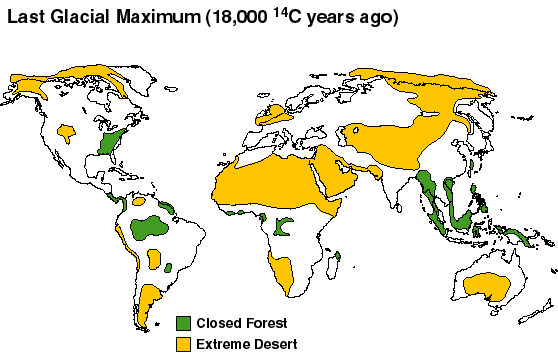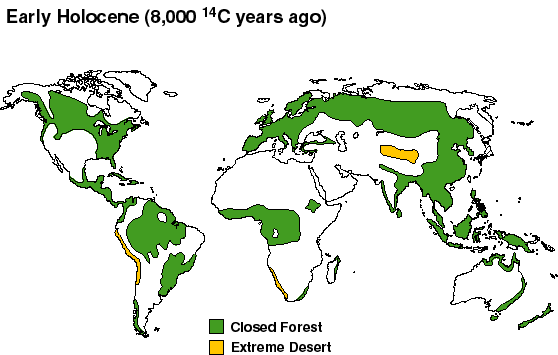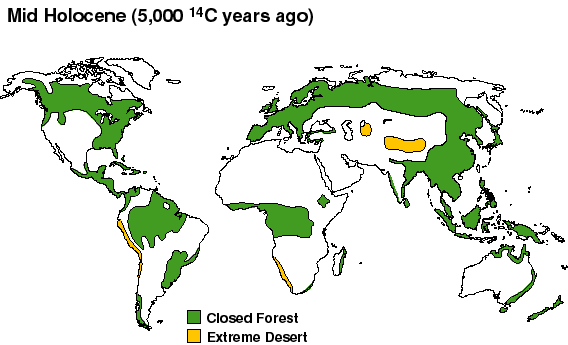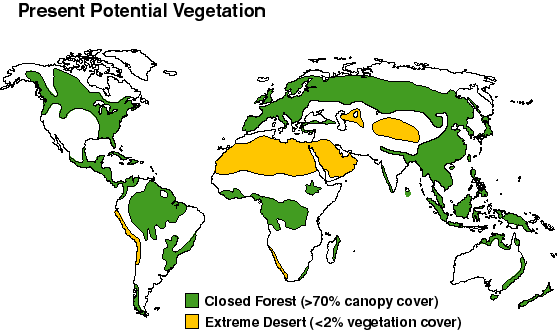After discussing how reducing CO2 could modulate H2O to produce a drier and therefore colder climate I want to review the evidence for that colder climate in the ice-age.
To recap
In the last article (How CO2 could control climate) I introduced the idea that we live in an effective CO2 desert geologically with unprecedentedly low levels of CO2. And how even a relatively small reduction in CO2 could dramatically affect plant life pushing plants away from the drier areas. This in turn would lead to a reduction in transevaporation from plants, a drying of the atmosphere a reduction in the necessary greenhouse warming effect of water vapour and a decrease in temperature again leading to less plant growth and less water. In effect, reducing CO2 might not on its own have the necessary greenhouse effect to alter the climate much, but its effect on plant growth and through in water vapour might.
See also:
- Introduction
- Criteria for Cycles
- Global warming and earthquakes
- Thermal crust expansion, decomposition and the Carbon cycle
- Overview of feedbacks
- Climate stability
- Hitting the buffers
- How CO2 could control climate
CO2 and water vapour feedback
In the 1950s whilst most people accepted that the world had had ice-ages it was difficult to discern any details except the scant information left by terminal moraine giving an indication of the greatest advance of the last ice sheets.
The in 1947, the nuclear chemist Harold Urey discovered a means to estimate ancient temperatures from the oxygen built into fossil sea shells. This relied on changed to the (O18/O16 ) taken up by the organism and then preserved in its shells. And as we have seen this can be used as a proxy thermometer.
Then a geology student Cesare Emiliani, working in Urey’s laboratory at the University of Chicago measured the oxygen isotopes in the microscopic fossilised shells of foraminifera, a kind of ocean plankton. These shells could be found in clay cores extracted from the sea bed. Moreover as they also contained carbon he was able to use Carbon 14 dating for the most recent layers from which he could estimate the rate of deposition. Together the C14 and O18/16 provided the first detailed estimate of temperature variations during the recent ice ages.
However, whilst Emiliani provided evidence of when the ice ages occurred and by how much the temperature changed, it was not until an ice core was extracted from Vostok by a French-Russian team that we obtained details of other atmospheric changes which began to help understand what might have caused the changes. The team retrieved the deepest ice core ever recovered, reaching a depth of 3,623 meters. Careful analysis of the enabled them to reconstruct trends of many climatic and environmental parameters, including temperature and CO2 concentration, over a period of 420,000 years.
Above is a series of measurements from the Vostok ice core paper (Antarctica). From top to bottom:
- Deuterium (heavy Hydrogen) – a proxy for temperature
- O18 in the atmosphere
- Ice volume (calculated)
- Na (sodium)
- Dust
The general shape of many of this curves is a “sawtooth”. For example Deuterium slowly drops down (with some small up and down perturbations) until e.g. at ~130000 years BP the level shoots up. This general shape is also present in ice-volume and is present to some degree in o18. The Na level is the inverse of this.
The only measure that is substantially different is that of dust. This is particularly interesting because the periods of dust precede the rapid rise and disappear as it starts rising.
The onset of this dust is strong evidence that either/or
- The climate dried allowing more dust into the atmosphere
- The wind pattern changed so that wind brought dust southward
Likewise the end of this period of dust is evidence the climate either/or
- Became wetter
- The wind pattern changed so that wind no longer brought dust southward
We don’t have a lot of direct evidence for wind patterns, however we do have evidence concerning the climate from the distribution of plants and geology in the past. This is shown by the following global maps:

Fig 9.2 Last Glaciation (source)
This shows that during the last glaciation much of the globe was desert and the forests were in isolated patches mostly at the equator. This clearly shows the whole globe was drier as well as there being ice at the poles.
But by around 11,700BP the earth had become far damper. The deserts had all but disappeared except for the Taklamakan desert in the rain shadow north of the Himlayas and in a thin band along the west of S.Americas (Atacama) and Africa (Kalahari). The forests now covered much of Europe and substantial portions of Asia and the Americas.

Fig 9.3 Early Holocene (source)
And the climate remained much the same for the next 3000 years.

Fig 9.4 Mid Holocene (source)
But today the present climate has again seen a resurgence of desert. In the North African Sahara and middle east. The Taklamakan & Gobi deserts are larger, the climate in the Karakum Desert east of the Caspian sea has become extreme.
Also the area of forest has diminished slightly.

Fig 9.5 Present (source)
This shows that the climate was drier in the glacial period, but that on its own does not account for the dust in the Vostok ice because we are now drier than during the early or mid holocene and there has not been a return of dust in the last part of the Vostok core.
So either:
- The the deserts in Africa are too far away for dust to reach Antartica
- Or, the wind pattern is not the same in the glacial
See also:
- Introduction
- Criteria for Cycles
- Global warming and earthquakes
- Thermal crust expansion, decomposition and the Carbon cycle
- Overview of feedbacks
- Climate stability
- Hitting the buffers
- How CO2 could control climate



Don’t know about Vostok, but the Greenland GISP2 and NEEM cores can be read for precipitation as well as temperature. You might want to look into that.
I have not yet checked references for confirmation, but your vegetation maps do weakly support your hypothesis. Weakly, because closed forest is not the only landscape that prevents dust. There is much hard evidence that 5000 years ago, the Sahara was a savanna, so that no dust would have been blowing off into the Atlantic. Weakly, because much of the biological CO2 sequestration is not terrestrial, it is oceanic. Current estimates are maybe 50/50.
But there is still a conundrum. The depths of the most recent ice ages persisted for many millennia during which the hypothesized dry, dusty, plant unfriendly conditions existed. What suddenly changes to start the rapid onset of warming out of that?